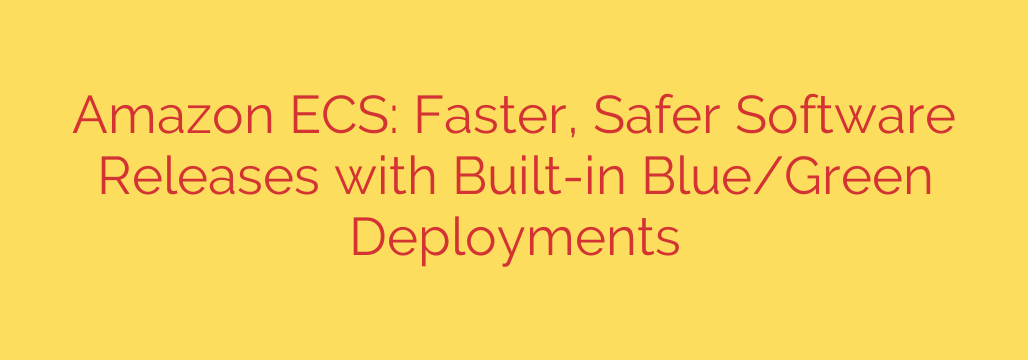
Streamline Your Deployments: A Guide to Blue/Green on Amazon ECS
In the world of modern software development, speed and reliability are paramount. Development teams are under constant pressure to ship new features faster, but every new release carries the risk of introducing bugs or causing downtime. For teams running containerized applications on Amazon Elastic Container Service (ECS), there’s a powerful, native solution to this challenge: blue/green deployments powered by AWS CodeDeploy.
This deployment strategy fundamentally changes how you release software, transforming a once-stressful event into a controlled, low-risk process. Let’s explore what blue/green deployments are and how you can leverage them to build a more robust and efficient CI/CD pipeline on Amazon ECS.
What is a Blue/Green Deployment?
At its core, a blue/green deployment is a technique for releasing new code with near-zero downtime. The concept relies on maintaining two identical, isolated production environments:
- The “Blue” Environment: This is the current, stable version of your application that is handling all live user traffic.
- The “Green” Environment: This is a clone of the blue environment that hosts the new version of your application.
The process is simple yet effective. Once the new “green” environment is deployed and running, you can perform comprehensive tests on it while it’s completely isolated from live users. When you are confident the new version is stable, you simply switch the traffic from the blue environment to the green one. The green environment becomes the new production environment.
The old blue environment is kept on standby for a short period. If any issues arise with the new version, you can instantly roll back by rerouting traffic back to the original blue environment, minimizing the impact on your users.
How Native Blue/Green Deployments Work on Amazon ECS
Previously, setting up a blue/green workflow on ECS required complex scripting or custom tooling. Now, this capability is a native feature, seamlessly integrated through AWS CodeDeploy. Here’s a step-by-step look at the automated process:
Initiate Deployment: When you deploy a new version of your ECS service configured for blue/green, CodeDeploy kicks off the process. It begins by provisioning a new set of containers (a replacement task set) with your updated application code. This is your new “green” environment.
Isolate for Testing: Your load balancer is configured with two listeners: a production listener serving live traffic to the blue environment and a separate test listener. This test listener directs a small amount of internal traffic to the new green environment, allowing you to run automated integration tests, smoke tests, or conduct manual validation without affecting any real users.
Shift Production Traffic: Once your tests on the green environment pass, CodeDeploy proceeds with the traffic shift. It seamlessly reconfigures the Application or Network Load Balancer to route all production traffic from the blue target group to the green target group. This cutover is instantaneous for your users.
Monitor and “Bake”: The new green environment is now live. CodeDeploy waits for a configurable period, often called a “bake time.” This is a critical window for you to monitor the application’s performance, error rates, and other key metrics under full production load.
Finalize or Rollback:
- Success: If the monitoring period passes without any alarms, the deployment is considered successful. CodeDeploy then proceeds to de-provision the old blue environment, freeing up resources.
- Failure: If you detect a critical issue during the bake time, you can trigger a manual or automated rollback. CodeDeploy will immediately switch traffic back to the stable blue environment, providing a safe and rapid recovery.
Key Benefits for Your DevOps Workflow
Adopting this native blue/green strategy on ECS offers significant advantages that directly impact your team’s efficiency and your application’s reliability.
- Dramatically Reduced Downtime: Traffic is switched instantly at the load balancer level, meaning your users experience a seamless transition with no interruption in service.
- Lowered Deployment Risk: The ability to fully test the new version in a production-like environment before it goes live is invaluable. If something goes wrong, the rollback process is fast and reliable, giving you a powerful safety net.
- Simplified and Faster Release Cycles: By automating the entire process, from provisioning to testing and cutover, you can eliminate manual steps and reduce the potential for human error. This allows your team to release new features more frequently and with greater confidence.
- Enhanced Control and Validation: The mandatory test phase and bake time give you built-in checkpoints to ensure quality. This encourages a culture of robust testing and proactive monitoring.
Actionable Tips for a Flawless Deployment
To get the most out of blue/green deployments on ECS, consider these best practices:
- Automate Your Tests: The test listener is only as good as the tests you run against it. Invest in a solid suite of automated integration and end-to-end tests that can validate the core functionality of your application.
- Define Your Rollback Triggers: Don’t rely solely on manual intervention. Use Amazon CloudWatch Alarms to monitor key metrics like CPU utilization, error rates (e.g., HTTP 5xx), and latency. Configure CodeDeploy to automatically trigger a rollback if these alarms are breached.
- Manage Database Changes Carefully: Blue/green deployments work best for stateless applications. If your new version requires a breaking database schema change, you must plan your database migration strategy carefully to ensure both the blue and green environments can function during the transition.
- Monitor Your “Bake Time”: Use the bake time actively. This isn’t just a waiting period; it’s your final chance to catch performance regressions or subtle bugs under real-world load before committing to the release.
By integrating native blue/green deployments into your Amazon ECS workflow, you can build a truly modern, resilient, and agile application delivery pipeline. It’s a strategic move that empowers your team to innovate faster while ensuring the stability and performance your users expect.
Source: https://aws.amazon.com/blogs/aws/accelerate-safe-software-releases-with-new-built-in-blue-green-deployments-in-amazon-ecs/








